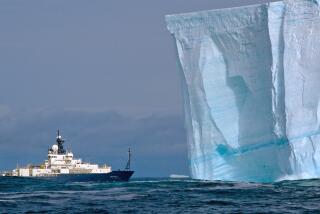Of Chilly People and Frozen Emotions : ICEFIELDS by Thomas Wharton; NeWest $10, paperback; 275 pages
- Share via
In 1898, a group of British scientists is exploring a glacier in the Canadian Rockies near Jasper, then still a frontier outpost. The expedition’s doctor, Edward Byrne, falls into a crevasse, losing his box of botanical specimens. As he hangs upside down, rapidly freezing, he glimpses “a white form embedded within the darker ice . . . a pale human figure, with wings.”
At this early point in “Icefields,” Thomas Wharton’s first novel, we wonder whether he has made a misstep as serious as Byrne’s. There are too many angels in current fiction. And why, we ask, is it necessary to force a specific meaning out of a landscape that--as Wharton, a native of Alberta, Canada, often demonstrates--is meaningful in itself?
The glacier is a marvelously versatile symbol. Slow-moving but immensely powerful, it gives birth to life-stunting winds and nourishing rivers. To local tribes, the ice field from which it spills is a “spirit place.” To the Victorian explorer Lord Sexsmith, who saw it a generation before Byrne, it embodies the “sublime.” The glacier constantly changes yet retains its shape. It kills yet preserves its victims from corruption.
No wonder it captivates everyone who comes in contact with it, especially Byrne. Recovering from his narrow escape, he muses on “the possibility of a spiritual entity trapped, frozen, in ice. Enmeshed somehow in physical forces . . . thus rendered physical and solid itself.” Every summer for the next 25 years, he returns to Jasper, camps on the glacier, measures its progress and waits for whatever he saw to appear at the terminus.
Frank Trask, the guide who rescued Byrne, exploits the glacier commercially, building a hot-springs resort next to it. Sara, who nursed Byrne after his fall, tells him stories passed on by her Indian-born father, Sexsmith’s valet.
Elspeth Fletcher, the hostess at Trask’s hotel, falls in love with Byrne and finds his obsession with the glacier to be her greatest rival. She, too, does a lot of waiting.
The people who fit in this harshly beautiful corner of the world are Canadians of English and Scottish descent--reticent people, by and large, emotionally frozen or unwilling to express what they do feel. Wharton, a disciplined stylist, is as sparing with words as they are. “Icefields” comes to us in hard little chunks, glittering but often opaque.
After World War I, Fletcher says, “People understood the world would never be the same. . . . There were a lot of sudden marriages.” She and Byrne consider wedlock but, typically, decide against it without a word being spoken. “We’d resisted the fever,” she says. “And now we could be ourselves again. I suppose neither of us felt very comfortable with grand gestures.”
Wharton’s own gestures keep us worried for a while. Byrne serves as the doctor for a track-laying project and witnesses the death of a worker pinned, Christ-like, to a rock by a railroad spike hurled by a dynamite blast. And when we learn that Byrne, Sexsmith and others are based on real people, we wonder if Wharton will meddle with history heavy-handedly.
In the end, though, “Icefields” reassures us. Wharton, it turns out, isn’t forcing any meaning on us; instead, he is stalking what, for a young writer, is rarefied game indeed: the playful ways in which people’s private mythologies just barely intersect, if at all.
Meeting the aged Sara on the streets of Jasper, the aging Byrne “sees himself as a character in a story told to her daughter, and perhaps some day to her grandchildren. The doctor, Edward Byrne. The one who fell into a crevasse. He wonders how the story she tells them, the one he is moving through now, will end.”
More to Read
Sign up for our Book Club newsletter
Get the latest news, events and more from the Los Angeles Times Book Club, and help us get L.A. reading and talking.
You may occasionally receive promotional content from the Los Angeles Times.









